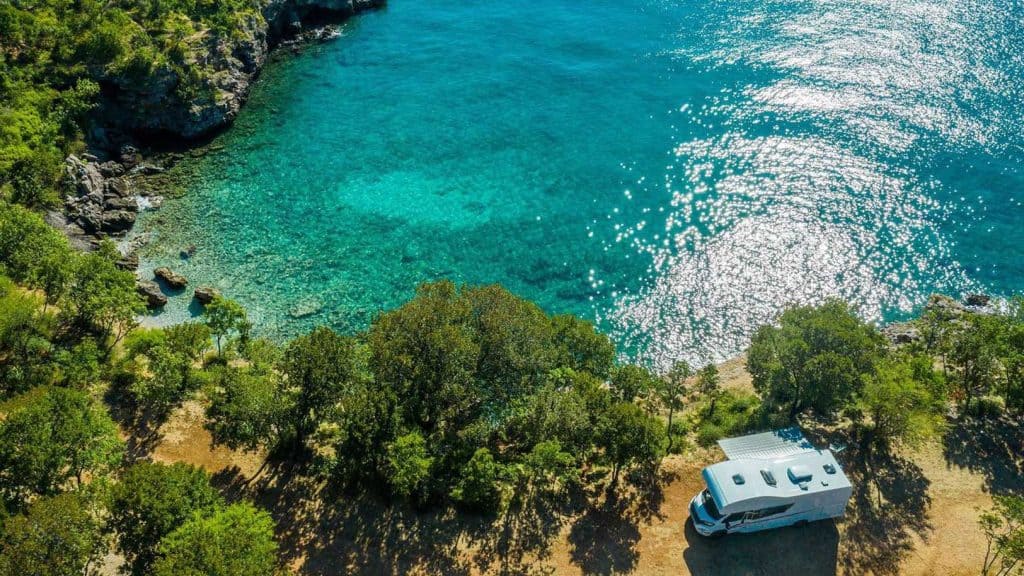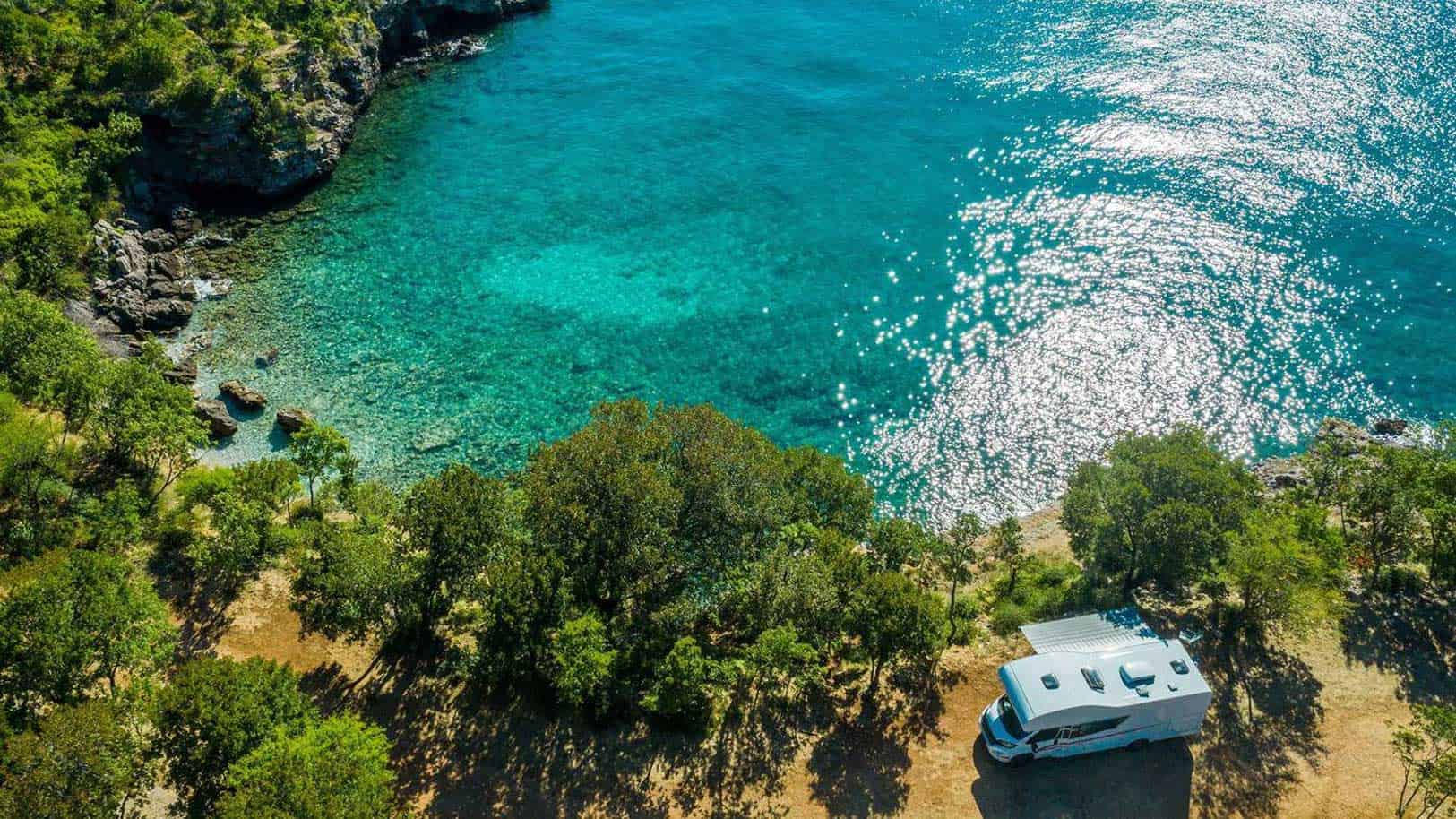Is it cost to live in an RV? Well, RV living expenses can vary greatly depending on a number of factors, such as the type of RV you have, how often you travel, and where you stay.
Some people can live comfortably on a budget of around $1,500 per month, while others may spend $5,000 or upwards per month. It all depends on your individual circumstances and lifestyle choices.
Contents
Cost of Living In an RV Full Time: Considering All Factors
How much does it cost to live in a camper? The exact cost will differ from one RVer to another, depending on their lifestyle. We’ll break down living in an RV full-time’s cost. You’ll get a clear understanding of what it takes to embrace this nomadic lifestyle and make it easier for you to plan your budget accordingly.
Purchasing an RV
People who already have a trailer can skip this section. However, if you’re yet to make the purchase, you must be prepared for this huge expense, buying an RV for full-time living.
We found that new RVs can cost anywhere from $30,000 to $500,000, depending on the class and model. However, pop-up campers, truck campers, and travel trailers are available at lower price points. Used models cost even lower, but you have to bargain to find one with a good condition.
If you don’t pay the full price in cash, your monthly installment, after deducting the down payment and other related fees, will be between $200 and $1,000. However, the amount depends on your negotiated terms.
Motorized RVs, such as Class A, B, or C, are more expensive than towable RVs, such as travel trailers or fifth wheels. However, motorized RVs offer the convenience of driving the rig, while towable RVs require a separate vehicle to tow them.
Insurance and Registration
RV insurance can cost you around $100 or $200 per month. But the actual cost will depend on the type of RV you have and the coverage you require.
You can expect to pay more for a hulking Class A motorhome versus a small pop-up camper. Insurance companies look at the value of the rig and the likelihood of damage, so bigger and pricier RVs equal bigger premiums. But discounts could be available if you have a stellar driving record or make a large down payment.
Registration fees are another ballgame. Each state has its own fees based on the RV’s weight class and such. Go to your state’s DMV website and check the fee. Many websites provide calculators to give you the accurate figure.
It is important to note that some states also require emissions testing and safety inspections for RVs, which can add to the initial costs of RV living.
Fuel Costs
A fair share of the cost of living in an RV full time goes for gas and propane expenses.
Fuel prices are kind of unpredictable and vary a ton state-by-state. Some spots might be around $5 per gallon, while it’s $3.50 just across the border. Our advice is to use GasBuddy or a similar app to scope out cheap stations on your route. If you’ve got a big tank like 40 gallons, saving a quarter per gallon adds up fast!
As for propane, that’ll run you $30-100 per month depending on weather and usage. We RVers rely on it for cooking, heating water, and running the furnace in cold temps. So, you can expect to spend more on propane in the dead of winter than sunny summer days. My best tip is to find cheaper refill locations, like U-Haul or RV dealers, instead of shelling out at highway rest stops.
Between gas for the truck and propane for the RV, you’ll likely spend $400-600 monthly when living in an RV full time. It’s a chunk of change, but strategizing fill-ups and parking in affordable propane spots helps keep costs in check.
Maintenance and Repairs
When you live in an RV full-time, maintenance and repairs are simply a cost of the lifestyle. It’s smart to budget for inevitable issues that occur.
Include regular maintenance like oil changes and brake pads in your monthly budget. Let’s say $200/month for routine truck and RV servicing. And set aside an emergency fund for major repairs. Aim for $5,000 or more solely for those surprise RV breakdowns on the road. You never know when the fridge or axle will go kaput.
On average, the maintenance and repair cost of living in an RV full time is around $2,300 yearly. But some years you luck out, and others get pricey with transmission jobs and such. Consider an extended warranty or RV insurance with breakdown coverage for some extra peace of mind.
And preventative care is key. Invest in tire pressure monitoring, change fluids regularly, inspect seals, etc. Catching problems early really pays off.
Campsite Fees

You can reduce the cost of living in an RV full time by finding affordable campsites. Let’s break down the main options and their average fees.
RV Parks: How much does it cost to live in an RV park? They are the priciest at $50-70 per night. They’re packed with amenities like full hookups, pools, and clubhouses. You’ll save a little with weekly rates, and some offer decent monthly discounts. But the crowded campgrounds are a turn-off for many.
National and state parks: These are a happy medium around $25-40 nightly. You get some comforts like electrical and water hookups alongside beautiful nature. There’s typically more space between sites than a cramped RV park. The vibe is less hectic too.
Public lands: And then there’s boondocking on public lands for free! This “dry camping” means no hookups and relying on your RV’s water tank and solar, if equipped. You can stay up to 14 days in national forests, BLM land, etc. It’s ideal for RVers with self-contained rigs.
For maximal cost savings, boondocking is the way to go. But having hookups for a week or two can be a nice break. Mixing up park camping and free public stops keeps your options open on the road.
Food and Groceries
Eating well on a budget is totally doable in the RV lifestyle. For that, you have to get comfortable cooking in your tiny kitchen. Eating out at restaurants, breweries, etc. really adds up fast. Being able to whip up meals yourself will reduce the RV living cost for sure.
For groceries, try to stock up at big box stores before hitting remote areas. Small town convenience shops jack up prices, especially in touristy spots. Expect to pay more for food in places like Yellowstone.
All told, plan on $800 per month or more for two people when you factor in groceries and some dining out. You can trim that number by boondocking and cooking from your pantry. Lots of RVers keep the cost of living in an RV full time within budget by baking their own bread, making coffee at home, and hunting for happy hour deals.
Phone and Internet
Reliable internet access is a must for work, navigation, and entertainment on the road. With a little planning, you can stay connected while keeping the cost of full time RV living down.
Verizon or AT&T are your best bets for nationwide cellular coverage. You want a strong signal even in small towns and remote campsites. Consider a plan with unlimited hotspot capabilities. You’ll rely on your phone’s hotspot to get internet when RV park WiFi is sketchy (and it usually is!).
With the right plan, you can keep costs between $50-100 per month. Look for discounts on data and unlimited hotspot.
The Hidden Costs of Full Time RV Living
When RVing full-time, some costs sneak up on you. By planning ahead for surprise expenses like the ones below, you can keep the cost of living in an RV full time down:
- Laundry adds up fast without an RV washer/dryer. Plan on $10-20 for laundromats if you do four loads of laundry per week.
- Toll roads are hard to avoid across the country. Get an RV TollPass for around $95 to save some headaches.
- Storage is necessary if parking the rig somewhere for a bit. Outdoor lots are $50/month, but indoor ones will be around $100.
- Doctor visits and medications require an emergency medical fund. Even with insurance, some costs come up.
- Repairs like a busted AC unit or slideout can hit at any time. You should have reserve savings for breakdowns to avoid financial stress.
FAQs About RV Living Expenses
What is a good budget for full time RV living?
A good budget for full-time RV living can vary based on individual preferences and circumstances. However, a common guideline is to aim for a monthly budget of around $2,000 to $3,000 for a comfortable and sustainable lifestyle on the road. This budget should cover essential expenses such as campground fees (if not boondocking), fuel, food, propane, insurance, maintenance, and miscellaneous costs. Keep in mind that personal spending habits, the type of RV, the frequency of travel, and other factors can significantly impact the overall budget. It’s crucial to plan and track expenses carefully to ensure a smooth and enjoyable full-time RV living experience within your financial means.
How much does it cost to live in an RV park?
The cost of living in an RV park can vary depending on the location, amenities offered, and the length of stay. On average, nightly rates at RV parks can range from $30 to $50, while monthly rates can vary from $500 to $2,000 or more. Some high-end RV parks with extensive amenities may charge even higher rates. Additionally, some parks offer discounts for longer stays or memberships. It’s essential to research and compare different RV parks to find one that fits your budget and offers the amenities and services you desire.
What do I need to live in a RV full-time?
To live in an RV full-time and embark on this nomadic lifestyle, you’ll need a few key essentials to ensure comfort, convenience, and safety.
First and foremost, choose an RV that fits your preferences and requirements, whether it’s a motorhome, travel trailer, or camper van. Stock up on kitchenware like cookware, utensils, and dishes, as well as bedding, pillows, and towels for a cozy living space.
Don’t forget essential toiletries and cleaning supplies to maintain a tidy home on wheels. Install safety gear like smoke detectors and fire extinguishers to prioritize your well-being. Consider power solutions such as RV batteries, solar panels, or a generator to meet your electricity needs.
Lastly, cultivate a nomadic spirit to fully embrace the freedom and adventure that comes with full-time RV living.
Embrace minimalism and the joy of discovering new places as you journey along the open road.
The Final Words
At the end of the day, RV living provides freedom and adventure at a fraction of what traditional housing costs. With smart budgeting for expenses like gas, repairs, and campsites, you can hit the open road long-term without breaking the bank. The RV lifestyle lets you live life on your own terms, if you’re willing to be frugal and flexible.
